Best Anime of the 2000s
When 2010 arrived, so did the “Best of the Decade” lists, with film, television and everything in between being covered over a variety of platforms. Outlets such as ANN, Japanator and AnimeDiet joined in with lists of their own. In case you are a newbie looking for a good place to start your anime journey, or a seasoned fan who is somehow running out of shows to watch, here is one more.
The Artifice asked a multitude of anime writers to come up with their favorite anime from the 2000s. Their choices have been comprised into this review anthology, which features 20 outstanding titles in no particular order. From touching romcoms like Toradora! and Lovely Complex, to nail-biting thrillers like Monster and Death Note, to mecha adventures like Eureka Seven and Tengen Toppa Gurren Lagann, to daring character dramas like Koi Kaze and Welcome to the NHK, to unique audiovisual extravaganzas like FLCL and Bakemonogatari, the decade is rich with variety and truly has something for everyone.
This article was a collaborative effort, so please enjoy all the different creative voices of the wonderful writers who contributed!
1. Monster (2004)

Renowned brain surgeon Kenzou Tenma is one day confronted with a choice: to save the town’s mayor or a young boy. Against his superiors’ will, he decides to save the boy— a decision that leads him down a dark and mysterious path.
By blautoothdmand
The works of mangaka Naoki Urasawa are a very good entry point for the anime and manga newcomer, in that they combine the familiar writing of your typical Western thriller series with the sensibility for unique narrative concepts that so often characterizes its Japanese counterparts. Whereas his other iconic work 20th Century Boys is more on the weird and kooky side of this sensibility, his acclaimed 1994 title Monster is the epitome of esoteric mystery. When studio Madhouse released the anime adaptation ten years later, they did an outstanding job at capturing these qualities.
The story is set in Cold War Germany, beginning in Dusseldorf in 1986. Kenzou Tenma is a young Japanese brain surgeon, who with his remarkable skills is a rising star in the hospital world. But after having saved a famous opera singer over a poor Turkish man, he is faced first-hand with the morally skewed corruption that permeates the country’s healthcare system. Meanwhile, a certain Mr. Liebert arrives in Dusseldorf from East Germany with his wife and two young twin children. A massacre at their residence leaves Mr. and Mrs. Liebert dead, the son unconscious with a bullet in his head, and the daughter in a state of traumatic shock. When the boy enters the hospital he is quickly followed by the town’s mayor who is in equally acute need of surgery. Tenma’s superiors order him to tend to the mayor, but tired of their corruption he prioritizes the boy since he arrived first. The boy is saved and the mayor dies, resulting in Tenma losing his career and getting dumped by his fiancée, the Hospital Director’s daughter.
As he despairs beside the boy whom he sacrificed everything to save, he wishes death upon his morally unjust superiors. The next day, his wish is fulfilled, and the Liebert siblings mysteriously disappear. Ten years later, when Tenma has regained his footing as a doctor (much due to the ill fate of his superiors), a patient of his is murdered in front of his eyes, and the killer turns out to be none other than the boy that he once saved. This marks the beginning of a long and dark journey for Tenma as he tries to unravel the mystery of this young man, and how to stop him.
From this summary of the series’ opening arc, one of its major themes becomes highly apparent: morality. While trying to uphold a moral compass in the midst of an immoral system, Tenma gets punished for his morally just actions and rewarded for his immoral desires. This leads to the question of how much it is worth sacrificing for doing the right thing, as well as what exactly the right thing is. Should a man so evil as to be considered a monster be killed for the greater good, or should he be given salvation? Should a doctor, someone meant to save people, take a life for the sake of others? And what becomes of him if he does— does he become a hero, or a monster himself? These difficult questions are continuously posed by the series through poignant narrative framing.
It’s hard to talk about Monster without talking about its antagonist. The character primarily known as Johan Liebert (but who doesn’t actually have a real name, which is both narratively and thematically relevant) serves as the epicenter of the entire show, and is regarded by many as the villain in anime. Glorified by neo-nazis and serial killers alike as a messiah, he is framed as the embodiment of ultimate evil who seeks to be the last man standing at the end of the world. Yet there are numerous nuances to him that go beyond this, as he’s tormented by his lack of identity and existential belonging. Ultimately, he is an incredibly enigmatic and psychologically complex character – as much a mystery to himself as to those around him. All of this is communicated in his amazing charisma of light tenderness mixed with creepy menace, brought to life by his seamless and stereotypically Aryan design, as well as Nozomu Sasaki’s excellent performance.
Beside its thematic qualities, Monster is also a really exciting story. Don’t let its 74 episode length intimidate you; this is an addictive show that you’re guaranteed to burn through while constantly glued to the edge of your seat. It has everything you could ask for from a commercially appealing thriller series: it has a large cast of fleshed out, well-rounded and interesting characters; it treats each of its many arcs, both big and small, with thorough care to make them as engaging on their own as within the larger context of the series; it has action and tension pumped up with fantastic intensity; and it knows exactly how to deliver dramatic buildup and catharsis in a satisfying way.
Yet added to this is an esoteric otherworldliness, as Tenma delves deeper and deeper into the darkest of rabbit holes at the furthest edge of human reality. It is mystery taken to a degree of apocalyptic sublimity, driven by the ever-so-perplexing question of “who is Johan Liebert?” This is achieved entirely without the inclusion of surreal or fantastical elements. That dedication to keeping both feet firmly placed in hard-lined realism is demonstrated visually, with its dim color palette, toned down character designs, restrained animation and complete lack of cartoonish expressivity. Indeed, it could just as easily have been live-action. The result of this combination of otherworldliness and realism is an exploration not of some alien darkness beyond human perception, but of the darkness within humanity itself.
With fascinating themes of morality, constructivism, psychology, identity and existentialism, all wrapped in an extremely well-crafted and entertaining mystery thriller, and featuring one of the most enigmatically complex characters in anime, Monster hits it out of the ball park. If you want a taste of the richly unique culinary world that anime has to offer served in an easily digestible dish for the uninitiated, then this is a great choice.
Further reading: Johan Liebert and The Joker: A Comparison of The Same Character
2. Hell Girl (2005)
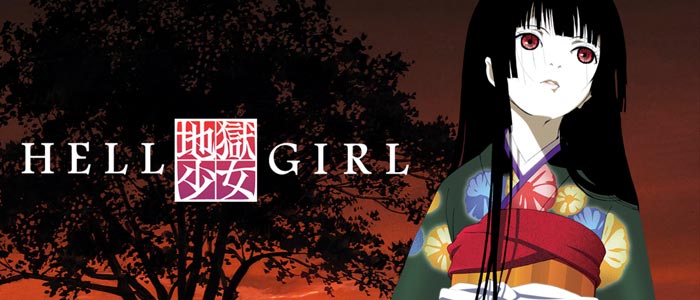
If you post a grudge at midnight on a particular website, the mysterious Hell Girl will appear and carry out your vengeance before dragging you away.
By Justin Wu and Jordan
Hell Girl is a dark series with serious themes about human desire. As with most episodic television series it features a number of writers, and therefore a variety of styles, each telling a separate story. The different characters are built up effectively within their limited screen time so that you come to genuinely care about them, and while the episodes don’t seem to be connected beyond the recurring appearance of the titular Hell Girl, that is what makes the show so foreboding: we know what is coming.
The visuals add an element of exquisiteness to the series’ motif about hell and the consequences of deeds in life through the incorporation of traditional Japanese folklore. In some of the more haunting scenes the imagery resembles that of horror films like The Grudge and The Ring, or anime series like Rozen Maiden and xxxHolic. The highlight of the visuals are the character designs by Mariko Oka (Ghost Hound), which are interesting and distinct with their oval-shaped eyes, pudgy faces and the sharp lines of their clothing.
Another feature that contributes to this anime’s uniquely dark atmosphere is its chilling soundscape. To absorb the audience and complete the mood, the chosen music does not adopt a glamorous style but instead remains simple and melancholic. Acoustic guitars and orchestral pieces play as the series explores and condemns the dark side of human nature. There are even moments when the absence of music makes a profound impact, and when simple sound effects or the sheer silence is captivating enough to make you want to watch more.
3. Ouran High School Host Club (2006)

Haruhi is a middle class tomboy who accidentally wanders upon the wealthy, glamorous Host Club of her school. To pay off a debt she must participate in the Host Club disguised as a boy.
By Mary Awad
“Kiss, kiss fall in love,” is the first thing heard when watching any episode of Ouran High School Host Club. With good reason, the mind automatically says “Oh God, not another one of these typical anime comedies.” But if given a chance, Ouran proves to be a quality satire with an array of crazy characters and laughs around every corner. The sheer ridiculousness of its plot and cast is what drives this story, centered around the Ouran Host Club where “the school’s handsomest boys with way too much time on their hands entertain young ladies who also have way too much time on their hands.” Through these self-aware introductions the audience is prepared for the mayhem that will ensue within Ouran Academy’s extravagant walls.
The protagonist of this tale, Fujioka Haruhi, attends Ouran thanks to her brains rather than her social status. When she breaks an expensive vase, she decides to join the group as a boy until she can earn the money to pay the club back. At first glance, Haruhi appears to be the only genuine and likable character in the show. But as the plot progresses, the boys get much needed development, each with his own personal quirks. Like the characters the club entertains, viewers will find themselves choosing their personal favorite host, whether it’s Haruhi or a member of the somewhat overly flamboyant supporting cast.
At times it is hard to tell whether the show is poking fun or being genuinely offensive, but given its comedic setting viewers can safely assume that it’s only trying to be funny. The Host Club for instance attracts the female student body by catering to their Lolita and twincest fantasies. There is also an otaku (obsessive anime fan) character, and the jokes that come with her may only be fully appreciated by those familiar with anime. Still, as odd as the show’s humor may be at times, it indisputably has an irresistible charm that has brought in many new fans to the medium.
Visually it may not be the strongest work in the studio BONES catalogue, but what character designer and chief animation director Kumiko Takahashi (Card Captor Sakura) has accomplished with Ouran is as elegant and enchanting as the school grounds of the academy itself. It fares around the same quality of the quirky, energetic School Rumble (2004) without dipping into the simplicity of other comedy hits like Azumanga Daioh (2002) or Lucky Star (2007).
Another way it successfully illustrates the “high culture” vibe is through Yoshihisa Hirano’s (Death Note) soundtrack, which is entirely orchestrated with a powerful string section and beautiful melodies. The colors of the opening theme song are bright, the music a sophisticated waltz, and the movements flourished just enough to really bring the viewer into the high class world of the Ouran High School Host Club.
Ouran mocks the affluent world while not taking itself too seriously. At points viewers may have to grit their teeth to get through some of the show’s ridiculous humor, but all in all it is a definite watch for anyone who wants a laugh and has “way too much time on their hands.”
Further reading: Slice of Life Anime: Insane Sanity
4. Toradora! (2008)
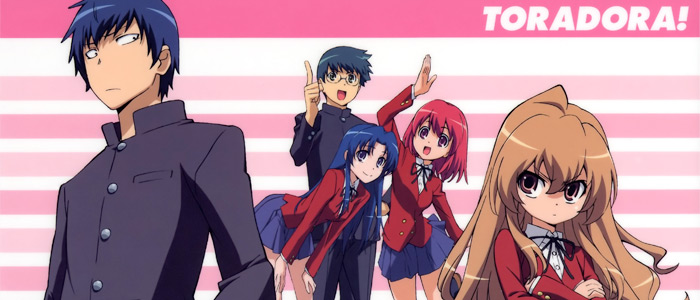
Two often misjudged high school students decide to help each other in their romantic endeavors.
By Mary Awad and Jordan
Negatively judged for their outward appearances, second year high school students Takasu Ryuji and Aisaka Taiga could not be considered popular by any standard. Ryuji tends to automatically be classified as a delinquent because of his narrow, intimidating eyes, even though he has a gentle demeanor and only wants to be liked. Taiga has a ruthless personality with a furrowed brow and violent tongue that immediately makes her peers want to hate her. When these two find out they have crushes on each other’s best friends, they form a strange but convenient alliance in order to help with the other’s love life. The two then find out that they live in the same apartment complex and form a strong friendship as they attempt to wade through the trials of love, high school and adolescence together. Soon, unsurprisingly, they realize that they have fallen in love with each other.
Toradora! is a typical love story that achieves its beauty through great character development and amazing voice talent. Each character is crafted and developed with heart, making for a believable cast that is always engaging to watch onscreen. These are subsequently placed in well-written, touching moments cleverly weaved into situations that, while very typical of anime, are made special in how much the show cares about the story it is telling.
The voice actors do an amazing job of bringing their characters to life. The emotion and inflection in their voices with every line is incredibly captivating and, for a romcom-turned-drama such as this, a big selling point. Their transitions from humor to seriousness help create the awesome atmosphere of tension and release that largely defines Toradora! The audio is on par in every other field as well— especially the music. The entertaining opening and ending themes, performed by the female voice cast (Kugimiya Rie, Kitamura Eri, and Horie Yui), align with the playful side of the series.
It is also visually stunning. J.C Staff may not be the most prolific studio, but has here created a beautifully animated world that looks gorgeous and moves with elegance. Even during the fast-paced and rougher parts, the animation maintains this graceful essence around it. The style utilizes rich, deep colors instead of the usual bright colors, giving the show a more mature and down-to-earth feel. The visual quality is thus a key factor that adds to the realism of the show. It ties together the genuine voice acting performances and beautiful backdrops to make it an attractive watch from start to dramatic, wonderful finish.
Toradora! is a powerful drama that shows the hardships and challenges of these two similar yet different characters’ lives and how they intertwine. The combination of the vibrant visuals, wonderful cast of characters and lovely music makes the ‘typical’ element of the love story stand out from a crowd of mediocrity.
5. Koi Kaze (2004)
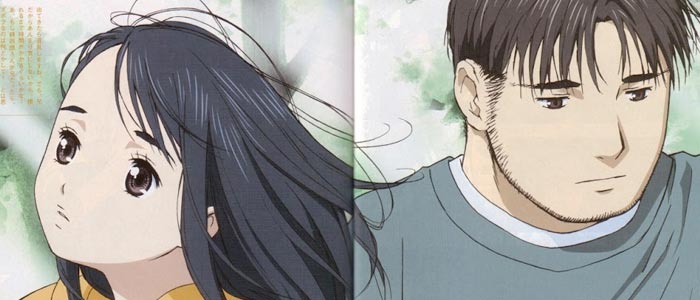
Saeki works as a wedding planner and has just been dumped by his girlfriend. He finds solace in a pretty girl at an amusement park and starts to develop feelings for her, after which they discover that they are siblings.
By Jordan
Let’s get the biggest roadblock out of the way: Koi Kaze is a story about accidental incest. But unlike many other anime that depict incest as a kind of fetish element, it portrays the development of this relationship in a very gradual, believable way. Based on a 2001 manga by Motoi Yoshida, the 13 episode series was produced by A·C·G·T (Kino’s Journey). It is one of the strongest character dramas of the decade, with a style and execution comparable to Rumbling Hearts but with heavier themes.
As a character-driven story, the show is more about the journey that the characters go through than any external plot. It initially focuses on the brother, Saeki—his thoughts and emotions, portrayed in a very humanizing fashion. With a bit of a tummy, a beard and broad features, his design adds an extra layer of realism. Then the focus slowly shifts to the sister, Nanoka. Her perspective is not explored as thoroughly, which, though slightly disappointing, is not a major drawback. Its 13 episode run doesn’t give much time to develop the other characters, but one in particular stands out as society’s voice, which adds a much needed and important contrast to the story.
The soundtrack by Makoto Yoshimori (Baccano!) and Masanori Takumi (Peach Girl) complements the series perfectly. Similar to the works of Makoto Shinkai and Rumbling Hearts, the majority of the score consists of piano pieces that work to set a somber mood. In some cases it is too much however, and it is highly recommended not to watch the entire series in one go as it can be incredibly draining.
The opening song by ef, which shares the name of the show, also fits the tone perfectly. Depending on how far into the series you are, different interpretations of the opening sequence can be made and thus it provides insight into the series’ themes. Though it may be uncomfortable to watch at first, you may find the sound of it to be heartbreaking and beautiful as you approach the series’ conclusion.
Koi Kaze is one of the only anime that depicts incest through a nuanced grey area, challenging views on incest through a fascinating character study and moving story. It may be a bit of a slow journey as the drama builds, but there are no filler episodes, and it has a great payoff at the end with intensely emotional moments where the cast truly shines. It is especially worth a watch for those turned off by the incest-fetish-side of anime, being a much more down to earth portrayal of the topic. The series is left open-ended, letting the viewer draw their own conclusions instead of being potentially swayed to think one way or another, or having a message shoved down their throats.
6. Welcome to the NHK (2006)
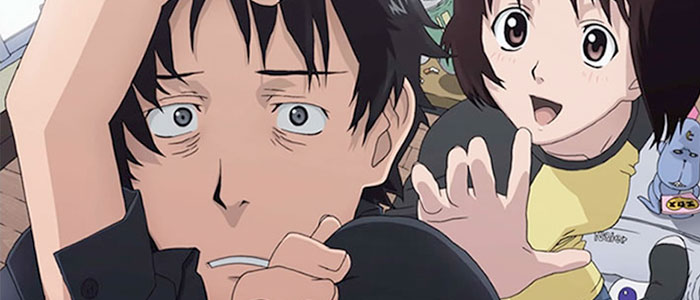
22 year old Satou is a NEET (Not in Employment, Education or Training) and a hikikomori (shut-in). He is encouraged to start going outside when a young woman claims to be able to save him from his emotional problems.
By Jordan
Welcome to the NHK is one of the best comedies of its decade, simply for its ability to consistently make one laugh out loud while balancing everything out with serious moments as well. The crux of the story is told from the perspective of the main character Sato, who in the original light novel has a drug abuse problem. The anime cuts out this detail, so those unfamiliar with the source material may find the first couple of episodes to be a strange experience as they ask themselves, “Why is the fridge talking?” and “What is with all the sentient furniture à la Beauty and the Beast?” In any case, Sato is in dire need of therapy – proper therapy – but since his social skills are so inept, the closest he can get to emotional support is through the willingness of a kind stranger named Misaki.
The story of Welcome to the NHK is interesting for a number of reasons, the main ones being the chemistry between the characters and the internal struggles they go through. Its cast is unlike that of much anime as it consists of young adults outside of a school setting. Sato is trying to deal with noisy neighbors, cooking, rent and looking good to his parents. He tries to deny he has problems by conjuring up a plan to convince both them and Misaki that he has a lot going for him in life. Meanwhile. the other characters are dealing with their own adult challenges. From the mid-point onward, it quickly turns away from its comedic, colorful exterior to explore various forms of mental illness and neuroses in a realistic manner.
Like Ouran High School Host Club, the series makes fun of otaku culture so not all the jokes may be understood to newcomers of anime. That said, the English dub expertly adapts the Japanese jargon to ramp up the comedy tenfold. Chris Patton is fabulous as Sato, and some of the more dramatic scenes mid-way could very well be his strongest and most emotive performances to date. Stephanie Wittels, who has mostly done extras in the past, joins the cast as Misaki, and the two are great together.
Tiptoeing the line between comedy and drama, Welcome to the NHK is a powerful series that will make the viewer laugh one moment, and then want to drink away their sorrows the next. The conclusion finds a happy medium between the two, culminating in the bittersweet reality of coping with and overcoming mental illness in the hectic, modern world.
7. Lovely Complex (2007)
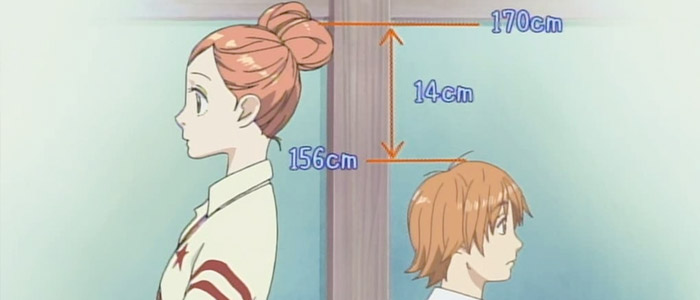
Risa and Otani always seem to be bickering about something, including their heights. Risa gets worried when her love-hate relationship for Otani begins to grow into something more.
By Mary Awad
Lovely Complex puts a spin on the stereotypical anime romance. It is the story of Otani Atsushi, a boy way shorter than the average Japanese boy, and Koizumi Risa, a girl way taller than the average Japanese girl. Both characters face mockery in their lives because of their heights and believe they have no shot of getting a boy-/girlfriend because of their “freakish” natures. Due to their peculiar and similar situations, Otani and Koizumi form a strange friendship based on helping one another find the person of their dreams. As the story progresses, Koizumi realizes that her quest for a romance with a tall boy is doomed to fail because she has fallen in love with Otani. And from this realization, chaos ensues.
The series’ entertaining characters more than make up for its average production qualities. Otani and Koizumi are extremely likable and fun characters to follow as their love lives teeter between pure bliss and a living hell. Both have strong personalities that make them just as enjoyable to watch individually as when they share the screen. Their characterizations are perfect and they complement each other on every level, resulting in believable comedy, drama and romance. They also face many realistic bumps in the road that resonate with the show’s target audience. Coming of age, plans for the future, teenage love, happiness versus practicality– Otani and Koizumi encounter all these problems along their journey which, with both its comedic and somber moments, creates an extremely engaging, enjoyable story that the viewers can take with them throughout their lives.
One of the elements that stands out in this anime is the influence of its setting: a high school in Sakai, Osaka. Every character speaks with a Kansai accent, which is very uncommon for a show televised in Japan on a national level. Even though the humor and puns that this aspect brings may go unnoticed for the non-Japanese audience, it is something that adds a level of realism to the show that wouldn’t have been there otherwise. With the vocal cast predominantly made up of native Kansai residents, the show achieves an extra dimension of humor and familiarity while also putting the spotlight on talents that may not have been recognized otherwise.
For all of these reasons, Lovely Complex is highly recommended. It’s a fun, feel-good show that exhibits emotions and concerns that everyone experiences at least once in their lives. It accurately captures the highs and lows that come with love, heartbreak and adolescence, while also managing to put a comedic spin on all of it.
8. Ghost in the Shell: Stand Alone Complex (2003)
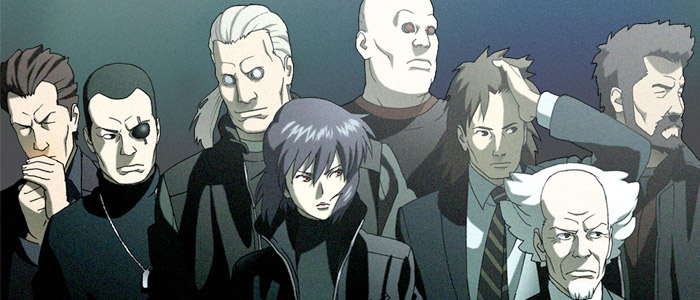
In a not too distant sci-fi future, Public Security Section 9 deals with various crimes.
By blautoothdmand
Since Masamune Shirow released his cyberpunk manga Ghost in the Shell in 1989, it has evolved into a highly regarded franchise with numerous iterations, ranging from Mamoru Oshii’s famous 1995 animated film, to the recent American live-action movie by Rupert Sanders. One of the more acclaimed of these iterations is Stand Alone Complex, a series with stellar production value, detailed animation, elaborate background design, top-notch sound design, and great score by none other than Yoko Kanno (Cowboy Bebop). With its likable ensemble cast, exciting narrative, and phenomenal world building, Stand Alone Complex transports its audience to a cyberpunk future proliferated by digital and cyborg technology.
At the core of the story is the beloved team of Section 9, Japan’s highest non-military law enforcement division which specializes in cybercrimes. Whether it be Batou, Togusa, Aramaki, or any of its less central members, they each add something special to the team and to the show’s ensemble dynamic. The iconic cyborg heroine Major Motoko Kusanagi is the star of the team, and she is perhaps best described as “professionalism incarnate.” She does her job, and she does it extremely well without compromise. With her in the lead, the team gets involved in countering everything from hacking, to terrorism, to political corruption.
We follow Section 9’s investigation of various cases in a primarily episodic format. All the while, a larger continual narrative spreads through each of the two seasons. It is much more polished than Shirow’s original manga, which had rich, deeply complex ideas but a somewhat uneven plot. This improvement makes for storytelling that is as exciting as it is intriguing, whether it comes to the major arcs or the smaller episodes that elegantly tie into them.
Additionally, Stand Alone Complex largely expands on the manga’s thematic groundwork. This could not be more evident than in the detailed world building, as many of its visionary sci-fi concepts are communicated via the various ways in which this futuristic society operates. In an extremely thorough manner the sci-fi context gets applied to every aspect of the culture, from politics to sociology, and from media to metaphysics. But, while being highly elaborate, the world building is also very seamless, avoiding exposition to instead provide the backdrop for the more prominent narratives.
Ghost in the Shell: Stand Alone Complex couldn’t be given a higher recommendation. It’s smart, it’s tight, and it goes above and beyond in exploring its sci-fi concepts. With intricate socio-political plotlines and thought-out concepts, it’s an intellectual treat and an exemplary representative of what the franchise has to offer.
Further reading: Anime Film for a Mature Audience: Features, Shorts and Directors
9. The Melancholy of Haruhi Suzumiya (2006)
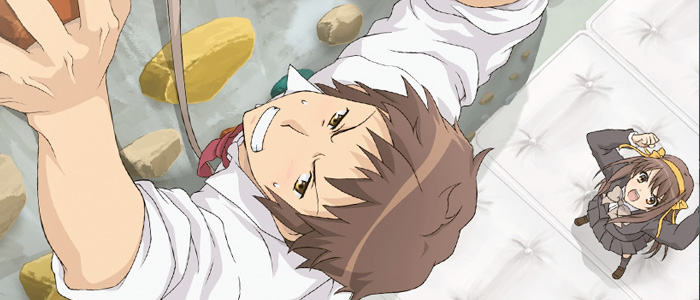
Haruhi Suzumiya is a bit weird. She claims to be recruiting aliens, time travelers and psychics to join her club: The SOS Brigade. Kyon, the guy who sits in front of her, doesn’t want anything to do with her, but gets dragged into the mix anyway.
By Justin Wu, Jordan and Mary Awad
When it comes to anime, Haruhi can be found everywhere. On advertisements, in videos, at conventions— she was basically this decade’s poster girl for the medium. The Melancholy of Haruhi Suzumiya (Haruhi going forward) led to an explosion of creative productivity in the anime online community with reviews, blog posts, fan-fiction—the lot. On top of that, it almost single-handedly introduced the idea of the ‘light novel’ to a wider audience, resulting in more and more anime being adapted from light novels like the one Haruhi is based off of. The series is not to be underestimated, owing its success to its interesting visual style, characters, and effective comedic elements.
To start off, the production qualities of Haruhi are so excellent that it propelled Kyoto Animation to the status of household name among anime fans. It was through Haruhi that the studio refined their artistic style, which then got carried over onto their subsequent titles Kanon, CLANNAD and K-On! With its 3D-looking character designs, wide variety of camera angles and impressively fluid animation, Haruhi not only looks technically amazing but also different from anything else that was coming out at the time. One only needs to watch the opening sequence to see what a visual standout Haruhi is. But perhaps its most memorable visual achievement is the shocking live music scene from episode 12 and the dance in the ending sequence, which has become a recurring feature in many anime conventions in Japan.
Another great feat is the comedy generated by the two main characters and their chemistry together: Haruhi and Kyon. Haruhi is a dynamic, attention-grabbing heroine who— uncharacteristic of a female lead—is brash, ruthless and often times downright unlikable. And then there’s Kyon, the voice of reason. He is perhaps the true reason for the show’s success and hilarity. There is nothing special about him; he is just an average Joe. But that’s exactly what makes him the perfect contrast to these crazy people and their unorthodox customs. Seeing through his eyes is one of the show’s greatest appeals. It fulfills the audience’s desire to experience the excitement of encountering an unknown force or God. In a mostly directionless show about aliens and gods and ghosts, Kyon is not only a window into a universe of out-of-this-world extravagance, but also the glue keeping it all together. Without him, it would be a mess and a horrible attempt at humor.
Being based off an unfinished work, the stories are mostly episodic with a few overarching plots here and there. Those interested in seeing what happens where the episodes end and the light novel continues can watch it come to life in the stunning feature film The Disappearance of Haruhi Suzumiya, which brings much more of the series’ dramatic plot elements to light.
To put it plainly, The Melancholy of Haruhi Suzumiya is a lot of fun. One of the best anime in the last decade, and a modern classic, it has comedy, asks some pretty deep philosophical questions, and looks great for an anime made in 2006 thanks to Kyoto Animation. It is highly worthwhile to watch, whether it’s to see something extraordinary happen in the mundane world, or simply to get the community’s inside jokes and references.
Further reading: The Melancholy of Haruhi Suzumiya: The Journey of The Hero and The Masked Tragedy of The Melancholy of Haruhi Suzumiya
10. Fate/Stay Night (2006)
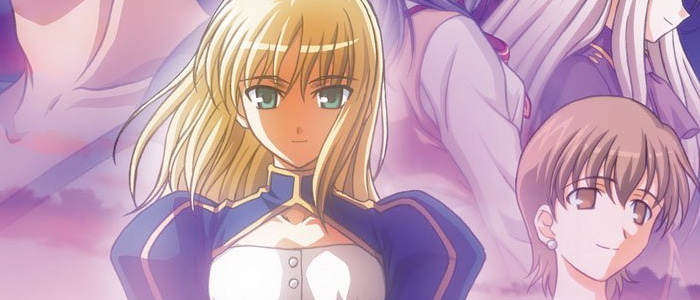
Shirou, the son of a magician, is drawn into a war for the Holy Grail, where teams have to fight each other to be the last one standing.
By Austin
Fate/Stay Night is the anime adaptation of a very popular visual novel by the same name. Studio DEEN has done a great job at translating the story to animation with fantastic visuals, great writing, and production quality that drags the viewer into a contemporary fantasy world. There, seven magicians are selected to fight for the wish-granting Holy Grail.
Without giving any spoilers, each episode perfectly serves its purpose as a single piece of a greater whole. The story is gripping, and even the most lax moments contain some kind of excitement and suspense. Whether it’s a romantic development between the main characters or the action-packed fight scenes, something of interest is always on display. Shirou and Saber make use of the center stage deftly, and it’s hard to resist the entrancement of watching the two grow together.
Beyond its stellar plot, Fate/Stay Night is a show with highly likable character designs and enough eye candy to keep one hooked until the end. The combat scenes are captivating to watch, combining impressive artwork with natural camera angles and solid fight sequences that are flashy but not cumbersome or tacky.
The music in Fate/Stay Night is a vital part of the viewing experience, because of how well it suits the mood and progression of the show. From the deathly morbid to the goofy morbid, there’s an appropriate track for any given moment. The absolute best parts of the soundtrack are the openings. The first opening paints an image of sadness– almost despair– in the face of confusion and frustration, which naturally progresses into a similarly serious second opening that exudes the feeling of grim determination to face the coming trials.
Fate/Stay Night is truly the sum of its parts. All together, they create a glorious and addictive 24-episode experience that makes it impossible not to start the next episode after each one ends.
Further reading: Fate/Stay Night: Setting Up for a Decade of Quality Success
11. Death Note (2006)
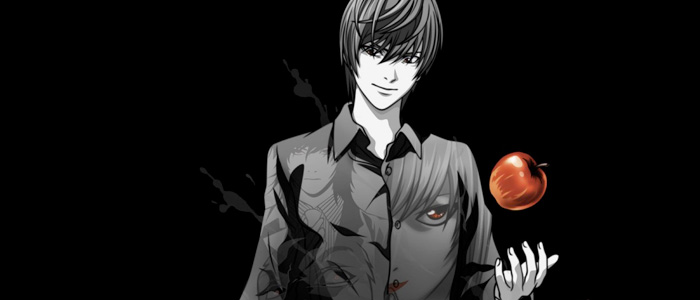
High school student Light Yagami one day comes across a notebook that has the power to kill anyone whose name is written in it. He decides to use it to make the world a better place.
By Adnan Bey
Simply put, Death Note is mind-boggling. The plotline is good, the characters are appealing, and it raises a significant question on the topic of crime. It has a little something for everyone, whether that be thematically or narratively. As far as the first season goes, Death Note is the perfect anime. As far as the second season goes, it is imperfect but still stands as a masterpiece.
This anime transcends the usual qualities of the crime genre due to the supernatural element that allows for intriguing scenarios to play out. The story starts out in the realm of the death gods. One of the gods, Ryuk, drops a notebook into the human realm—a notebook with the power to kill anyone whose name is written in it. It gets picked up by honor student Light Yagami, who after testing it out takes it upon himself to play God and make the world a better place by ridding it of criminals. The frequent, similar deaths make the police suspect some unexplained foul play, and the world’s greatest detective, known only as L, gets onto the case.
Another way that Death Note differs from genre norms is in its use of dramatic irony. Crime shows usually involve a murderer whose identity is unknown, even to the audience, and follow detectives and police as they try to chase down the criminal. The engagement comes from keeping the audience guessing through various clues what the truth behind the crime is, until finally they arrive at a revealing climax. Death Note however gives all the information to the audience at the beginning, creating an omniscient point of view. Neither Light nor L knows the other’s identity, and the two enter a mental cat-and-mouse game, each trying to outsmart the other, each proclaiming to be the Hand of Justice.
What makes this anime such a great watch are the various themes that it explores: crime and punishment, genius, and obsession. It displays a moral dilemma between two paths: the humane path where everybody is given a second chance, and the harsh path where every criminal (regardless of what crime) dies as an example to others. These paths are subsequently framed around the conflict between two geniuses who frequently try to gain a footing over the other, especially in the second season. Finally, the characters’ obsessiveness is displayed in the quirky—almost eccentric—habits and way of handling things. For example, one of them always feels the need to sit in a particular fashion, claiming that if he doesn’t he loses forty percent of his capacity to work. Another feels the obsessive need to twirl his hair, especially while playing with toys. Ryuk is obsessed with apples, and another death god is obsessed with a mortal human.
In Death Note, the line between hero and villain is not divided by narrative perspective, but is left for the viewer to decide. As the weak are continuously manipulated by both parties, the story is characterized by moral ambiguity in the vein of serving “the greater good,” and that ambiguity is what gives it such intrigue. Ultimately, this is not only a fantastic starter anime but also one worth revisiting time and again.
Further reading: Death Note and Dr. Faustus: Transgression, Fate, and Religion’s Influences and Death Note: Light Yagami’s Transformation a Ruthless Killer and Death Note: A Second Look At Morality
12. Eureka Seven (2005)
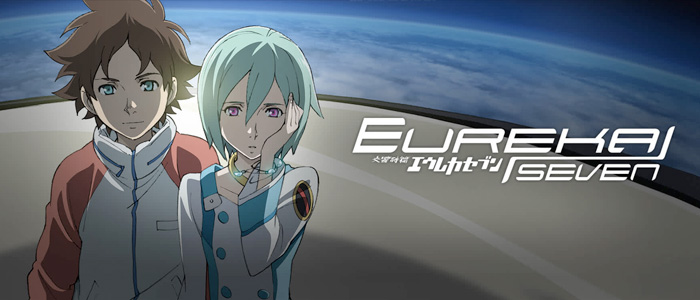
Renton’s life is dull and uninteresting, until a girl crashes into his house with her giant robot.
By Jordan
Eureka Seven is a show that starts off lovely and remains consistently so throughout. It is the coming of age story of fourteen year old Renton Thurston, told through his observations, thoughts and feelings. The realistic characters, beautiful background designs, and musical variety set it apart from other mecha anime.
The greatest feat of the series is its memorable and unique cast of characters with loveable qualities and quirks. Up until episode 13 the show is mostly episodic, focusing on developing the characters and dropping various hints to foreshadow what’s to come. As the story begins to take shape, watching them develop is interesting to say the least. Particularly the romance between Eureka and Renton is believable and enjoyable to watch as it unfolds.
Their strong character designs consist of realistic proportions and a variety of facial and bodily structures. The color design is fairly soft and easy on the eyes, as is the lighting. Often in series with highly saturated color pallets the color composition doesn’t collaborate very well with particular shades of lighting, but because of its more toned down visual approach such is not the case here.
The amount of dedication that went into creating the universe of Eureka Seven is impressive. It almost feels like a world you could walk right into. Though it varies depending on location, at best the backgrounds approach the height of Studio Ghibli’s level of detail.
The soundtrack by Naoki Sato (X TV) is amazing, with everything one could possibly want. Not only are there varied and numerous instruments, but so many beautiful and unforgettable melodies adding power to certain scenes. Throughout its 50 episode run it contains four different opening and ending songs, which vary from powerful ballads, to hip hop and RnB, to techno and rock.
With lovable characters, beautiful animation, a powerful soundtrack, and a story full of surprises, Eureka Seven is worth the time it takes for it to display its true colors. Keep in mind that the series is far more enjoyable when you can relate to the adult characters as well, and is therefore recommended to a slightly older audience, despite its teenage main character.
Further reading: Should Eureka Seven AO Be Seen Before Its Predecessor?
13. The Full Metal Panic Franchise (2002-2005)
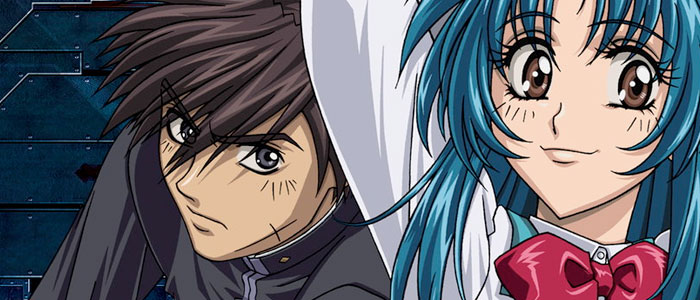
Teenage soldier Sousuke Sagara goes undercover to protect a high school girl named Kaname Chidori. She is under surveillance for reasons Sousuke’s independent military division won’t explain.
By Jordan
Adapted from a still ongoing light novel series by Shoji Gato, Full Metal Panic left a big impact in the 2000s, and is a title worth becoming familiar with. Season one was adapted from the first three volumes by GONZO, a studio known for hit and miss quality. While it is largely considered the weakest of the three seasons, and is most often associated with nostalgia viewing, it still captures much of the franchise’s great qualities: the characters are memorable and the story is simple but engaging. Seeing it is necessary to viewing the superior subsequent seasons by Kyoto Animation: the second season spinoff comedy classic Fumoffu (2003), and the third season 13 episode sequel The Second Raid (2005). A fourth season premiered shortly prior to the publishing of this article.
An emotional roller coaster of intense drama, action, touching romantic aspects, and beautifully animated action sequences, backed by a powerful soundtrack, The Second Raid is the strongest installment in the Full Metal Panic franchise. Through it, Kyoto Animation demonstrates what the first season could have been if it had been shorter (and to be frank, not handled by GONZO). Its two protagonists are strongly challenged in their life choices, which, along with being separated from each other, allows them to reflect on who they are as people. It is a touching, interesting process that brings a lot of humanity to a story that previously had only been straight action comedy.
The Second Raid remains one of if not the strongest work to come out of Kyoto Animation. It was so good that it became somewhat of a novelty in its time, and still holds up to today’s standards– a true testament to the studio’s dedication to their work which has endured ever since. The animation shines in the action scenes, background movement and even lifelike depictions of body language. Take for instance the famous scene where Kaname gives Sousuke a haircut. Taking into account the subtle nuances of hand and hair movement, facial expressions and breathing, it showcases the detail and precision present in Kyoto Animation’s work even when there’s not much going on.
Meanwhile, whereas the animation may improve between the first and second seasons, the audio aspects remain consistently high in quality throughout the entire franchise. The soundtrack, with its orchestral arrangements, gives the series a Hollywood blockbuster-esque sensibility. Mikuni Shimokawa sings all of the theme songs, from the incredibly catchy and memorable pop openings to the somber or bittersweet endings. What’s more, the English dub unwaveringly portrays believable emotions, which is particularly important for this series given its dramatic aspects.
Full Metal Panic is a classic franchise that any anime fan should try out, with the groundbreaking third season being a must-watch for those who liked the first one, and a worthwhile viewing even for those who did not. While thus far even the later seasons only scratch the surface of its admittedly simplistic story, the exceptional character interactions and the cross-genre mixture of school life antics, mecha, action and science fiction are what make it so entertaining. The charm lies in its execution: the varied tone and content of the episodes give the series a surprisingly large amount of re-watch value and make it a classic of the early 2000s.
Further reading: What to Expect from Full Metal Panic Season 4
14. FLCL (2000)
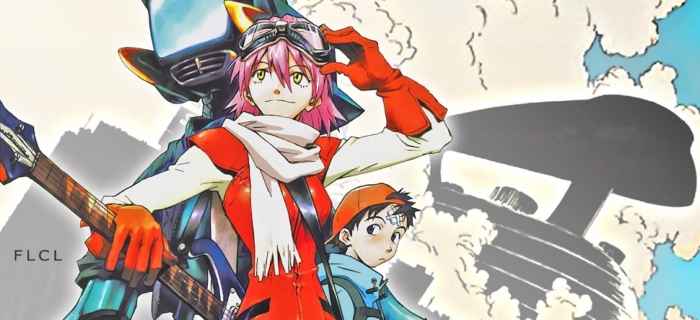
Naota’s life is normal, maybe too much so. That all begins to change when a strange woman crashes into him with her motorcycle and hits him on the head with her guitar.
By Mary Awad
How does one even begin to describe FLCL? It’s a creation like no other. Its colors, sound and overall atmosphere are extremely fun and entertaining, and while the show is virtually mindless it can often be thought provoking. This collaborative piece between Gainax, Production I.G and Starchild Records pulls out all the stops to make an incredible anime that excels in every area: technical prowess, entertainment, and character development, engaging the viewer along every turn with its over-the-top cast and outlandish story.
FLCL follows middle-schooler Nandaba Naota whose life is changed when he is hit by a bright yellow Vespa driven by Haruhara Haruko, a woman from outer space searching for a robot known as The Pirate King. After the accident, Naota’s forehead becomes a gateway for intergalactic robots that wreak havoc on the town of Mabase. In the midst of Naota’s eccentric family and friends, Haruko’s strange practices, and the mysteries surrounding the Medical Mechanica Company, he is thrown into an adventure he never thought he would encounter in his uneventful life.
What makes this show stand out the most is its soundtrack and visuals. One of the best anime soundtracks out there, the music was written and performed by the band The Pillows who did an excellent job at portraying the feel of the show in their alternative rock compositions. It is not often that an anime has an all-rock soundtrack, but FLCL executes this excellently. The music is incredible and crescendos at all the right points to reel in the audience and get their blood pumping. This, paired with the visual direction, captures the grandeur and imagination of the series. The characters move fluidly through the screen in predominantly pastel colors until the action happens. Once the robots enter the stage, the colors become more saturated and the animation takes an upbeat, rapid pace while still being smooth and entrancing to watch. The music and visuals crescendo in perfect unison, working together to make the climactic moments of the series unforgettable.
Narratively, Naota’s coming of age tale is the show’s greatest triumph. For his entire life he has lived in the shadow of his older brother Takusu, who is away playing baseball in America. By attempting to be the same as Takusu on every level—practicing baseball and hanging out with his ex-girlfriend Mamimi— Naota almost gives up becoming his own person. Haruko and Mamimi don’t even address Naota by his own name, calling him Ta-kun as though he were a younger version of his brother. Knowing his internal struggle and watching him fail at being an individual is distressing and pitiful for the sympathetic audience. But near the end of the series, Naota realizes that he just should be himself, an epiphany so well deserved and fulfilling that it sparks one of the most amazing moments in FLCL and arguably in all of anime.
This section was introduced with the question “How does one begin to describe FLCL?,” and that was not intended for dramatic effect. It’s funny, at times thought provoking, and does a great job making its viewers resonate with Naota as he deals with his hectic life. At the same time, the plot of this cult classic is extremely confusing and largely unexplained throughout the show, making it difficult to digest at a first watch. It requires at least three or four watches in order to understand the chain of events and its effects on the characters. Consisting of a mere six highly re-watchable episodes, that isn’t too difficult to do. FLCL is a puzzle that has to be solved through hard work – but solving that puzzle is extremely satisfying.
*Author’s note: Although given a rating of “PG-13,” its incorporation of sexual themes and cheeky humor reserves it for an adult audience.
15. Samurai Champloo (2004)
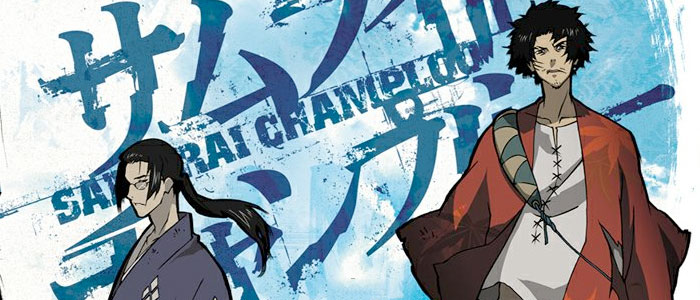
A trio of two swordsmen and a young woman set out on a journey in search of a mysterious samurai that smells of sunflowers.
By Mary Awad
Created by Shinichiro Watanabe, the director of Cowboy Bebop, Samurai Champloo is a beautifully crafted piece that uses characters and environment to take the viewers on an unbelievable journey. Watanabe’s storytelling ability shines throughout this series as he braids different stories and subplots together to create interesting episodes filled with depth and development. Produced by Manglobe, the show’s earthy colors add a much needed element of realism that keeps the plot and characters grounded. The fight scenes are action-packed and seamlessly animated, the characters’ expressions are fluid and believable, and the overall look of the anime personifies what the series as a whole is trying to accomplish– to show the lives of three peculiar individuals while mixing different cultures to create a cohesive, thoroughly enjoyable anime.
The central ensemble cast consists of three bold personalities: Mugen, a delinquent street fighter with no personal goals; Jin, a quiet, traditional samurai with no master; and Fuu, a quirky, loud-mouthed girl who brings them all together. Due to an interesting turn of events, our trio travels together in order to help Fuu find a man known as “the samurai who smells of sunflowers,” whom she’s been searching for her entire life. But due to various circumstances (usually caused by Mugen and Jin trying to kill each other) things do not go as planned, and the group is pulled into many unwanted adventures on their journey.
Champloo’s plot is straightforward and easy to follow. The series is mostly comprised of single-episode story arcs with the occasional two-parter that spans over a diverse range of genres. It doesn’t require too much attention to keep up, which allows for a suspension of disbelief as one follows the characters through their amazing adventures. Many of these adventures are straight up funny on the level of hilarity. Others do cover some darker and more mature themes, but the show’s tendency to rely on dark humor prevents it from becoming too grim and keeps the atmosphere lighthearted.
Due to its simple plot, each character gets the appropriate amount of screen time to develop throughout the course of the series. The characters are the driving point of the show and act as its most entertaining element. Mugen does tend to take a bit more of the spotlight due to his “go big or go home” attitude that shines brightly among an otherwise reserved cast. However, all three characters are equally as important and equally as stupid, allowing the hilarity of their lives to play out organically. The character designs match up perfectly with their personalities and give each character a bit of personal flair that adds to their exaggerated dispositions. This is a motley crew the audience will remember fondly, years after finishing the show. There will always be a little place in their hearts for this over-the-top dysfunctional family.
One of the most interesting aspects of the Samurai Champloo universe is its anachronistic style. While taking place in a setting that predominantly appears to be Japan’s Edo period, it mixes this with 1990s Harlem New York to create a world where samurai and hip hop coincide. The show smoothly shifts from sword duels to graffiti gang wars while being extremely self-aware about it, forcing the viewers to come to terms with the anachronistic elements themselves rather than providing an explanation. Its soundtrack is a reflection of this as well, sampling traditional Japanese music to hip hop beats. Its opening and ending themes are both excellent in providing more contrast between the two cultures.
Overall, Samurai Champloo is a must-watch. With intriguing characters, an easy story, and aesthetically appealing battles and settings, there’s really no good reason not to watch it. It may get a little dry in the middle due to its repetitive episode structure, but Mugen, Jin and Fuu grab hold of you at episode one and don’t let go until the satisfying end.
Further reading: Violence in Anime: Helpful or a Hindrance?
16. Bakemonogatari (2009)
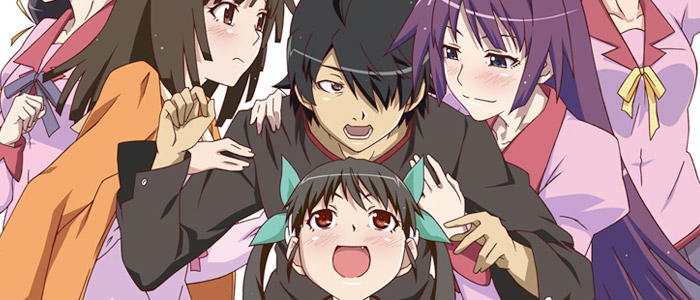
High school student and half-vampire Koyomi Araragi helps various girls with their supernatural problems.
By Justin Wu and Jordan
Light novel author Nisio Isin’s Monogatari was thought to be impossible to adapt into an anime, but when studio Shaft and director Akiyuki Shinbo took on the challenge with their addition to the franchise, they not only succeeded but also created one of the most amazing series of the decade.
What initially strikes viewers the most about Bakemonogatari is its abundance of seemingly pointless and nonsensical dialogue, set to a uniquely expressive visual direction of minimalist background and color design, rapid editing, flashing title cards and dramatic character expressions. This may sound weird and off-putting, but through constantly clever dialogue and creative directing, the show proves to be fun, energetic, and engaging through all of its antics while maintaining a special emphasis on characterization.
The series reimagines the done-to-death harem situation by centering around its many female characters in their own personal arcs, each ranging between three and four episodes. With so many distinct and likable personalities to choose from, every viewer is bound to have a favorite cast member – whether it be the sharp-tongued Senjougahara, the tomboyish Kanbaru, or the motherly Hanekawa. Each character’s arc can potentially be watched independently from the rest of the show (albeit without the contextual knowledge about all the side characters).
The minimalist music by famous composer Satoru Kosaki, along with the five character songs that serve as OPs, allow the viewers to experience a specific feeling and style that correspond to what each arc is about. Uniquely, the seiyuu (anime voice actors and actresses) sing the OPs for their respective character arcs, which further adds to their distinctiveness.
The casting and performances of the seiyuu are phenomenal; seldom does one find an anime where each seiyuu fits so perfectly into the characters they are voicing. The perhaps strongest performance is that of Kana Hanazawa, who has established herself as one of the most prominent seiyuu of our time and whose character song “Renai Circulation” has become known as one of the most ‘brainwashing’ anime songs.
Bakemonogatari’s style, personality and form of storytelling are fairly unconventional—and that makes it stand out from the majority of works out there, especially from those of its time. Because of this, and because it’s one of the most successful and inspiring titles of the decade, it’s well deserving of its place on this list.
Further reading: Fanservice in Anime: Perception Versus Intent
17. Mushishi (2005)
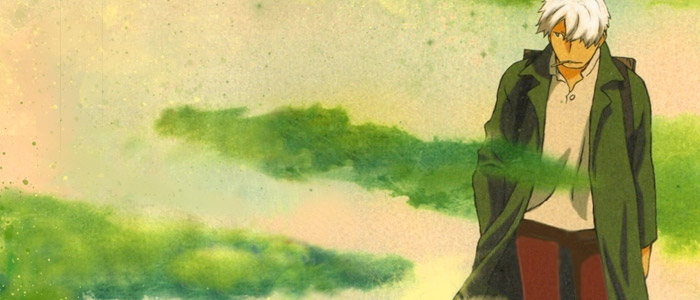
Ginko wanders the woods, helping people with their various problems that involve natural organisms called mushi.
By Joseph Manduke
The anime adaptation of Yuki Urushibara’s manga Mushishi has with its high-concept themes and enticing atmosphere attained a significant level of popularity in recent years, acclaimed by audiences and critics alike. It follows the mysterious Ginko, a man who wanders Japan helping to protect people from mushi, primitive beings that most people cannot perceive. An analogy spoken by Ginko early on suggests that mushi exist on the deepest and most fundamental level of the natural order. While mankind exists on one plane, the mushi are more closely connected to the very core of nature. Problems with Mushi often arise from a lack of understanding the creatures. Herein lies one of the main concepts of the series: Man has strayed so far from his natural roots that his lack of understanding could lead to dire consequences.
The series is set in an alternate Japan of the past, apparently between the Meiji and Edo periods when the country was still mostly closed off from Western influence. During this time, industrialization was just around the corner, threatening the traditionally valued bond between people and nature. Most of Mushishi takes place in secluded villages deep inside the country, featuring characters who are closed off from the changes of the modern world. This adds a timeless atmosphere that permeates the series, complemented by its vibrant forests.
While the mushi narratively function as antagonists, they are more representative of human conflicts than they are standard villains. Ginko meanwhile takes on the role of a sage of sorts, offering words of wisdom in the episodic vignettes that make up the series. Ginko himself is the only aspect truly linking all of the events together. He acts as a conduit to connect the audience to the hidden world of the mushi, while also providing the exposition. His calm and generally pleasant demeanor adds to the overall sense of sleepy wonder of each episode. However, much like Ginko himself, the episodes can change dramatically with flairs of intensity when events become more serious.
Mushishi will draw you in with relatable stories abundant with thought provoking ideas. Each episode could be seen as a philosophical tutorial of sorts, and it is recommended that the viewer takes some time between them to let the story sink in properly. Doing so may slow down the act of watching, but the viewer will nevertheless find themselves quickly absorbed into the unseen world of the mushi.
18. Tengen Toppa Gurren Lagann (2007)
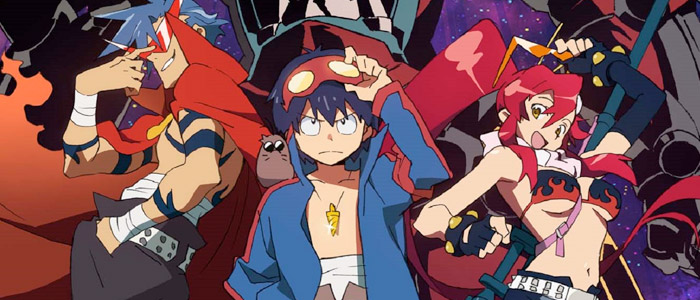
Kamina and Simon escape their secluded underground village after they come across a giant robot.
By Mary Awad
It is hard to talk about this show without becoming an overly hyper-emotional mess that screams about camaraderie, spiral power, and manhood. This action-packed adventure pushes unimaginable amounts of adrenaline through the veins, puts the audience in the driver’s seat early, and brings them on an incredible ride that they’ll want to relive over and over again. Thanks to its incredible cast, exciting plot, and masterful animation and soundtrack, Tengen Toppa Gurren Lagann (TTGL) is an anime with the incredible ability to elicit the entire emotional spectrum from its viewers over the course of 27 unforgettable episodes.
Its greatest achievement, and the first thing that attracts viewers, is its visual style. Gainax went all out to create a vivid, colorful world that reflects the childlike splendor the protagonists feel when they walk on Earth for the first time. The animation never misses a beat, keeping up with the fast pace of the show’s awesome battles, and making it dynamic to watch no matter the mood or the setting of the scene.
The story centers around Simon and Kamina, two boys living underground due to the belief that there is no world above. Kamina however believes that there is something greater in the world, and tries every day to break through the ceiling and discover the world he was always told about as a child. His dream comes true when the ceiling collapses and the two are brought into a world where humans fight to survive due to the vicious beastmen that rule the globe. TTGL quickly changes from what looks like an action-adventure RPG to an all-out mecha-war with robots that become humanity’s only weapon to fend off their extinction on the surface.
The energetic Kamina and thoughtful Simon are functional foils of each other and the two star in a cast of dynamic, entertaining personalities. The series’ larger-than-life plot is grounded by relatable and fundamentally human characters that viewers ally themselves with from the very beginning of the show. Everything about it, regardless of its fictional setting, is very real. It illustrates the pursuit for a better world, natural curiosity, suffocating grief and the innate need for companionship that all people experience.
Exploring the human condition in a beautiful way that resonates with its audience and keeps them engaged, TTGL is an anime anyone can watch over and over again and still experience the same emotions they did when they were watching it for the first time. The Dai-Gurren Brigade will make you proud to be a member of humanity, determined to face any obstacle that stands in your way, and will change your personal mantra to the anime’s defiant anthem, “Row! Row! Fight the Power!”
Further reading: Mechas: Disassociation from Science Fiction
19. Eden of the East (2009)

Akira Takizawa wakes up one day naked outside of the White House with a gun, a phone and over a billion yen. Japanese college graduate Saki Morimi is visiting America with her friends and meets Akira. After a series of misunderstandings the duo works together to unravel the mysteries surrounding Akira’s amnesia.
By Jordan
One of Production I.G’s best works of the decade, Eden of the East has something for everyone: an intriguing story, wonderfully voiced and likable characters, great visual quality, and an awesome soundtrack. The 11-episode series follows a Battle Royale-type premise, with a number of people having to participate in a “death game” set up by a mysterious antagonist. As a mystery, it gives enough information to make you hooked by the first episode and then keeps you wondering with suspense.
While on the one hand delving into fairly heavy themes of social and political commentary, Eden of the East also holds a joyful atmosphere with its humor, charming characters and hints of romance. The amusing chemistry between main characters Akira and Saki is especially entertaining to watch.
Production-wise the series is almost on par with film, visually appearing more like one long movie cut into eleven segments than a TV-show. The background art is highly detailed and gives much depth to the surroundings. The character designs by Chika Umino (Honey & Clover) strike close to home with an emphasis on realism while also retaining an endearing cuteness with soft lines and rounded faces.
Accompanying the visuals to provide rich atmosphere is a soundtrack of modern arrangements composed by Kenji Kawai (Patlabor, Ghost in the Shell). The opening song “Michael ka Belial,” performed by Saki’s voice actress Saori Hayami, is with its low profile a great complement to the credits— whereas the alternate English track “Falling Down” by Oasis provides some much needed buildup and tension; if you want to see a pretty opening sequence, this is one to seek out.
With near-flawless visuals, great music, interesting and likable characters in a fast-paced and gripping plot, Eden of the East sets the standard high. The series ends on such a fitting and touching note that, despite the fact that it was finished with two films (The King of Eden and Paradise Lost), it holds its own as a standalone. Indeed, it demonstrates the level of quality that drives fans to watch anime in the first place, making it the perfect choice for a newcomer.
20. Fullmetal Alchemist (2003) / Fullmetal Alchemist: Brotherhood (2009)
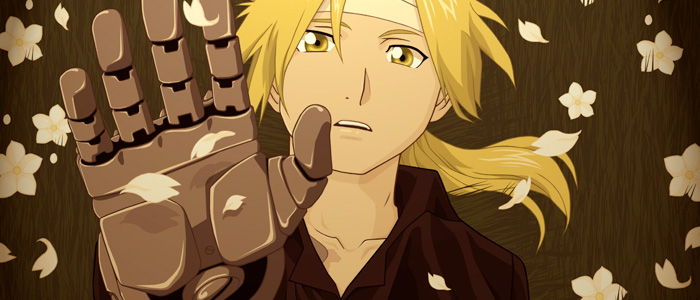
Brothers Alphonse and Edward Elric are confronted with the bad side of alchemy when they try to bring their mother back to life. They set off on a journey to reclaim what they’ve lost.
By Adnan Bey
Fullmetal Alchemist is one of the most widely beloved anime and manga franchises of the decade for a reason. With all-around excellent writing and craftsmanship, Fullmetal Alchemist presents a story of action, adventure, fantasy and character drama likely to strike a chord with anyone.
The story starts out with the two young brothers Edward and Alphonse trying to revive their deceased mother through alchemy. Breaking the Law of Equivalent Exchange, which states that obtaining anything means sacrificing something of equal value, Edward loses an arm and a leg and Alphonse loses his entire body while his soul gets encased in a suit of armor. The two brothers then change their goal to finding a way to restore their bodies, and their journey takes them to the central city of Amestris where they sign up for the governing military.
Edward Elric acquires the title of State Alchemist and all of the responsibility that comes with it in return for the right to research the Philosopher’s Stone. The legendary stone is a substance believed to forgo the Law of Equivalent Exchange and grant any of the possessor’s wishes. As their journey progresses, hidden truths are gradually revealed about the military, the upper echelon, the State Alchemists as well as the origin of alchemy.
The series explores a variety of themes, of which the most prevalent are war and philosophy. The theme of war is present in the history of the given setting, including past genocides against a specific ethnicity and parallels to real-world events and cultures. The philosophical theme is mainly rooted in the Law of Equivalent Exchange, held by the Elric brothers as an absolute truth to be applied as much to alchemy as to all aspects of life.
However, their moral compass becomes increasingly challenged due to the enemy’s use of alchemy— not to mention the unfolding conspiracies within the military that blur the line between friend and foe. Whose side are they even on? What is the motive behind each of the military’s actions? If given their way, what would the world look like? Most importantly, is obtaining the Philosopher’s Stone worth all the trouble?
With its heroically epic story, large cast of well-rounded likable characters, and themes of war, religion and philosophy, Fullmetal Alchemist has a little something for everyone, and whether watching the original series from 2003 or the 2009 reboot Fullmetal Alchemist: Brotherhood, you’re guaranteed to have a great time.
For a breakdown of the differences between the original and the reboot of Fullmetal Alchemist, see this article: Fullmetal Alchemist: Differences Between the 2003 Version & Brotherhood.
Further reading: Fullmetal Alchemist Brotherhood: The Symbolic and Ironic Deaths of the Homunculi and Full Metal Alchemist: Science vs Religion
Final Words
To summarize an entire anime decade in only 20 titles would be impossible, but that hasn’t been the aim of this article either. Rather, it has hopefully provided an entry-level insight into the many different stories that the anime of the 2000s – as well as anime in general— has to offer. The list has included not just some of the most highly regarded titles in this mixture, but also lesser known shows. Thus, while it can function as a good starter pack, even the well-versed anime watcher may have come across some new discoveries.
This article was the collaborative effort of a number of The Artifice’s anime writers, making it more than just an anime list. Beyond showcasing the different stories that lie within the past anime decade, it also showcases the different voices that exist on this very platform. It should therefore be an encouragement to not just explore the anime of the 2000s, but the portfolios of all the people who contributed to it:
Project Lead: Jordan, blautoothdmand
Lead Editor: Candice Evenson
Contributing Writers: Austin, Joseph Manduke, Justin Wu, Mary Awad, Adnan Bey.
What do you think? Leave a comment.




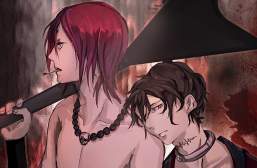
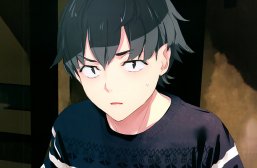

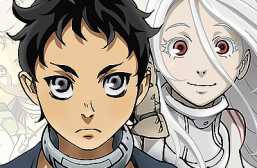
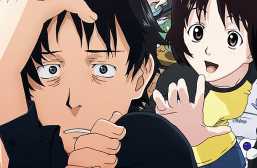
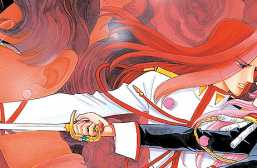
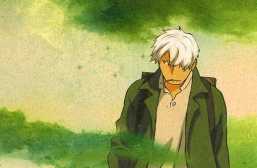
I was hoping to see hunter x hunter but then i remembered its from 2011 (yes i know its in the title I’m just stoned) and the original adaptation is from 1999. Maybe we can see hxh 2011 on the next list.
Super into the 2000’s now! Am currently watching Ouran and Toward the Terra, have Higurashi on-hold. dropped Samurai Champloo and have been planning to watch quite a few of the titles for some time now.
You dropped Smaurai Champloo? I thought it was one of the series almost anyone can like. O well.
So much here to explore and come back to, probably enough to keep me entertained well into the next decade. Fantastic list, a good service to everyone.
I vastly prefer Brotherhood but I am glad I watched the original anime first because the way they handle the introduction of Ed’s automail and Shou Tucker is so much better. Hate the ending of the original though.
Fullmetal Alchemist 2003 is way better than brotherhood! Brotherhood had way too many plot points and characters to keep track of. I often forgot most of the side stories while watching it. FMA is heartbreakingly beautiful with an amazingly beautiful orchestral soundtrack.
I just don’t understand why everyone loves Brotherhood. Horrible pacing, mediocre music, (except Again) and it just assumes you are familiar with the subject matter. I think the first Full Metal is superior in every way.
Lovely list. I haven’t finished reading every entry just yet, but I did give the whole thing a cursory scan.
So I know that this will make me look like an idiot for just bringing it uo around all of these beautiful animes, but I would like to hear your analysis of Naruto.
The Melancholy of Haruhi Suzumiya was a very amazing anime.
Thanks for including “Welcome to the N.H.K.”, undoubtedly best anime i’ve seen. Realistic slice-of-life but unbelievable in every aspect (characters, soundtrack, plot, just everything). Might say it changed my life.
Samurai champloo was a good show, I love the soundtrack even better.
Full Metal Alchemist Brotherhood the best series ever.
I will never watch Fullmetal Alchemist or Brotherhood in English. Never. I hate Edward’s voice in English, it’s soooo annoying.
I would put fma up against a song of ice and fire, lord of the rings, the wheel of time to stand alongside as one of the greatest fantasy stories ever
I don’t think any anime to this day pass these anime of the early 2000s. Obviously the visuals have improved but I would say everything else has declined. The storytelling, romance and action just isn’t the same as it was back then.
My top 5s best anime in my opinion
1.Fullmetal Alchemist Brotherhood
2.Soul Eater
3.Madoka magica
4. Death note
5.Pokemon♡
Can believe you didn’t put hunter x hunter on there it’s a great series with the best fight scene in all of anime Meruem vs Netero.
HxH was made in the 2010s (and in the 1990s as original version), but not 2000s.
Ah… Baccano (glad it was mentioned somewhere here)! I’ve seen nothing but praises for this anime. Some people even saying it’s one of the best anime ever made. And it does seem great.
Though their are many good anime from this decade and previous decades.. but did not find any one as intense and gaming as code geass. Their is lot of politics and tricks and game plane that makes it really the only one. Though Gudam series are also really good but personnel all time favorite is code geass.
Love the 2000s. I liked Mushishi a great deal, and Spirited Away was good. Hagane no Renkinjutsushi seemed good until the 2009 series blew it away. I loved everything to do with Rurouni Kenshin, including all of the OVAs.
Great list. So much nostalgia. By and way, if you’ve watched Mushishi, have you watched Kino no Tabi (Kino’s Journey) yet? It follows the same principle of a person constantly wandering to see more of the world (Mushishi = the beauty of the mushi, Kino no Tabi = the beauty of the world’s ugliness) and although the anime’s art is a bit simple, the original light novels’ art is quite lovely, and each episode talks about a different aspect of human nature, highly recommend it~
Girls Last Tour is in the same vein, highly recommended if you ask me. The anime stops before the end of the manga though, which is too bad because the ending is perfect.
I really need to watch Monster. It seems that everyone absolutely love it; I guess I’m just missing out.
Judging from the list I’d say the preference is slow, deep or thoughtful animes with beautifully-drawn artwork, the artwork in many of these are stunning ^.^ There were a number of ones I’ve already seen and enjoyed in the list, and there were a lot more that I have a feeling I’ll be enjoying as well, thank you very much!
It’s quite nice to see some anime lesser-known over here, Naruto and Bleach are all fine and dandy but we need to expand our horizons!
Wow what a great read! Really enjoyed this decade list! I’m going to definitely add some of these to my Netflix.
I love all these retrospectives that’ve been popping up in the writing community lately. It’s just a warm and fuzzy feeling to reflect upon all the excellent titles and groundbreaking moments that molded the medium over the past decade. I definitely plan on giving my considerations as well! Just signed up on The Artifice.
A mentioning of Samurai Champloo and not telling about the awesomeness of the epic as hell baseball episode as a reason for greatness? Blasphemyyyyyyyyyyyyyyyyy! XD
I only recently started watching Ergo Proxy, and is very good. Go watch is worth your time.
I don’t know if Fate/Stay Night should be on this list. The original Studio DEEN adaptation was a pile of flaming garbage. I’m not comparing it to the later Ufotable works, that would be cruel and unusual.
As an adaptation of the original Fate route, it’s pretty awful. Animation was way behind the times, music was pretty good though. It pulled from the other two routes (UBW and Heaven’s Feel) to make this weird chimera-story of all three, and did poorly as a result.
Death note was the most amazing anime, and then they killed L and my life changed.
I love Toradora <3 Is cute romanse !
What about Soul Eater? Soul Eater is sooo awesome and cool. The fights, the relationships between the characters, the philosophy, the art style, the music, the comedy. It was totally cool.
I love Naruto, Gurren Lagann, and Fullmetal Alchemist Brotherhood.
My favorite 2000s Anime’s are: ElfenLied, Blood+, Kanon2006, Ef-a Tale of memories, Kimi ga nozomu eien, Higurashi no naku koro ni, jigoku shoujo, Eureka seven, Toradora, Tokyo Magnitude 8.0 and Ergo Proxy.
I tip my hat off to you for compiling such a wonderful list. I knew I was in for a treat. It’s well researched, and it’s obvious you all know your stuff. I don’t really write comments on things like that, but I just saw the list after seeing another top decaude anime list. And their list, well, left a /lot/ to be desired.
Nice to see that you didn’t forget some of the more meaningful anime of this decade!
Niiice, I actually plan on watching a few of those animes myself. While reading through the list, I was thinking “I guess they doesn’t have Mushishi…” but when I saw that it was there, I was like, “FUCK YEAH!” Anyways, great list, absolutely adored these shows.
These lists are fun for discussing our preferences and reflecting on and sharing our experiences during the decade. Because our individual experiences differ, extensive lists, like this one that’s 20 titles long, always showcase new and interesting series to different people, and highlights the fact that there are always more great shows out there to discover.
Bleach is literally at least 10 times better than Gurren Lagaan, same could be said for Death Note (also better than Gurren Lagaan). Bleach is also better than Naruto. Both Bleach and Death Note are better than FMA Brotherhood hands down. Brotherhood moved too quickly and never worried enough about character and plot development and presentation and cut off too much from the manga; Brotherhood was surely less dramatic than Fullmetal Alchemist, and turned out to be (in my opinion) only a 4 out of 5 show.
Well done on writing this article; I’m staggered by its length, yet you’ve fired me up enough to perhaps write my own!
Interesting list. Quite a number of series I haven’t seen yet that I’ll take note of, and then maybe I’d also get to make a decade list sometime.
Best classic anime ever:
* FMA brotherhood
* Code Geass
* Full metal Panic
My favorite is kaichou WA maid Sama, special a, la coroda Doro and ouran high school the host club.
I’ve seen almost all of these. I recommend most of them. The ones I haven’t seen are the harems (many girls and one guy) but most of the other ones I’ve seen and my favourites are Mermaid Melody, special A, Fruits basket, and Kaichou wa maid sama. Pretty much all of them are great like inuyasha.
Great list! I’ve read a few of these lists and this one is probably the closest to what I would personally put down – which turned out great!
It’s good to see your article go live and great to see such varied responses in the comments section.
Since helping during the editorial stage, I discovered another anime series that, in my opinion, deserves a place in the ‘best of’ category – ‘Shoujo Shuumatsu Ryokou’ (aka ‘Girls’ Last Tour’). Slow moving and philosophical, yet strangely compelling, despite its inevitable conclusion (for which you have to read the manga series), it’s one of those stories that, I feel, deserves more recognition.
Anyway, thank again for your article. A good read indeed.
I haven’t seen much anime but mine top 3 will be death note , fmab and cowbot bebop in no particular order.
It is so strange feeling – i know them all! Maybe i’m so old?
I grew up watching OHSHC. It’s so fun but really easy to watch. Absolutely recommend.
I grew up watching OHSHC. It’s so fun but really easy to watch. Absolutely recommend.
Death Note was super interesting too!
I absolutely approve of this list!
I’m fan of Pakemon cartoon which’s totally based on ANIME and now in this 21st Era there’s many platform who are providing these kind of services.
Thank you for sharing, I will chase some of these up for my viewing pleasure.
My favorites are: Deathnote, Fairy Tail, Naruto, Fullmetal Alchemist, Pokemon.
Interesting , it indeed looks like a comprehensive list of best anime of 2000’s , though you said it is list of best anime of 2000’s its actually a list of few anime pieces of gold , all said it is one of the best lists I’ve seen until I realized one thing .
I read it in the final words you said
“To summarize an entire anime decade in only 20 titles would be impossible, but that hasn’t been the aim of this article either”
that line essentially forces me to stop saying or complaining about few other great anime you forgot to mention that released in 2000’s
so I am gonna
“kick the logic to the kerb and do the impossible”
1 . Hunter x Hunter
2 . Bleach
3 . Naruto
though everyone might not accept the clearly evident fact that the afore mentioned anime are great I must oblige that these are most influential among anime in the pact decade
and there are other anime including which in your list is your choice but I would have if I were you
1 . Code Geass
2 . darker than black
well that is just my view , its just a comment , please ignore it if you see so
but one thing is true , my fellow writer I really appreciate your skill to write research and your sheer dedication to anime
all that said the above list is really a ” good starter pack”
just as you said thanks, I had a great time reading it
I applaud your effort in putting this whole article together, even referencing other articles. Thank you!
Thank you for your attempt. How about Children’s Wolf and the Forest of Fireflies? I think they are also great animes in 2000s.
honestly the only anime in this list that i have watched in this list is Fullmetal. its is one of the best the anime industry has to offer. some like moster and mushishi are on my ever growing “to watch” list of anime. they keep getting ignored because of the newer installments like, noragami, tokyo ghoul and boku no academia.
helpful note! It’s very insightful.
Welcome to the NHK, Samurai Champloo, Mushi-Shi, and FLCL really ought to be mandatory watching. Absolute gems.
Really loved the list, and now I have some anime to start watching after. A few I may recommend that should be on this list (my opinion), are:
– Code Geass
– Fairy Tail
– Bleach
– Blue Exorcist
I think it would have been cool if you talked a bit more about the shonen anime that were prominent from the 2000s.
I’m so glad Welcome to the NHK was listed here. It’s by far my favorite anime. The grounded slice-of-life premise, the flawed yet compelling characters, and the surprising amount of heart present throughout are all reasons it has stuck with me half a decade later. While there is some unnecessary filler, it’s still a very solid 24 episode series. I could actually feel an adrenaline rush during the show’s climax, I was that invested in it.
I guess the only major downside to having watched it is I doubt anything will surpass it for me. I just watched it at the right time in my life.
Great list! Enjoyed every anime on this list.
I’m glad that the description of Koi Kaze mentioned the incest, so that I know never to watch that. The incest scare in From Up On Poppy Hill was enough to ruin that movie for me, and that couple turned out to not even be related!
I think this list is quite good, despite some absences of a few favourites. Baccano seems the biggest omission to me, although I think Cross Game would’ve been a great series to have here, as this list is lacking in the sports genre. Code Geass is another series I enjoyed from this decade, or, rather, the first season of the show is; if Death Note can get recognition in spite of its lousy second half, though, I think that first season of Code Geass deserves praise (still, if only one of Code Geass and Death Note can be on this list, Death Note really is the better choice).
I understand why FLCL is on this list, but I’ve always disliked that series and have tried giving it a chance three or four times now. I don’t really understand why Fate/Stay Night is on this list, though, and it’s the one choice that feels out of place. Yes, the great visual novel that the series is based on came out that decade, but the good anime adaptations from the franchise (Fate/Zero, Unlimited Blade Works, and the Heaven’s Feel movies) all aired in this decade. I’d give Fate/Stay Night an honorable mention, maybe, but I wouldn’t put it on a list of the top twenty anime of the decade over other series.
I have watched 4 anime series in this list. Definitely the best ones (for me) were Death Note and Fullmetal Alchemist: Brotherhood, which were the first anime that I ever saw. I feel that more anime could have been included – I was surprised Code Geass wasn’t included. And Baccano should also have been there. It was a very interesting series, with a nonlinear storyline and quirky characters. Overall, though, it was a good list.
Oh, and Hellsing/Hellsing Ultimate. Definitely. Very intense, very violent, very good.
Where’s Code Geass??
There are a lot of anime here that I thought at first glance didn’t sound to be great (most of which I found on Tubi TV haha), and now having read the article I will certainly revisit.
At the same time, I don’t think the list is an absolute as there remain many anime of the 2000s that missed the list and are equally worthy. what matters is there is good anime!
Otaku defines a person who has obsessive interests and actively participates in a wide variety of topics, including anime, manga, cosplay, collectibles and more.
What about Dragon Drive?
Great list! I cannot recommend Samurai Champloo enough, and it’s awesome to see it here even after all these years!
Why is FMA: Brotherhood not in the top 3. It’s got to be on the top 3. It’s GOAT.
FMA is one of my all time favorites and as a teen I learned alot from it. I’m shocked to see Code Geass didn’t make the list though.